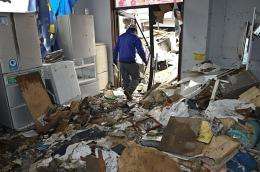Fukushima triggers new look at mega-quake threat

The disaster that has befallen Fukushima is prompting some experts to cast a worried eye at the risk of massive earthquakes to nuclear plants in seismic zones.
Twenty percent of the 440 commercial reactors in operation around the globe are located in areas "of significant seismic activity," according to the World Nuclear Association (WNA), an industry group.
Some of the 62 additional reactors under construction are also in quake-prone zones, along with many of the nearly 500 units on order or proposed, especially in fast-developing countries.
Many plants -- including the four Fukushima reactors crippled by the March 11 tsunami -- are located on or near coastal areas in the "Ring of Fire", a 40,000-kilometre (25,000-mile) arc of tectonic faults circling the Pacific.
The nuclear industry stresses that location in a seismic zone is not by itself a problem.
Engineering norms meet scientific estimates, it says.
Reactors are generally designed to withstand "the largest earthquake which can reasonably be expected to occur at the site of a nuclear power plant," according to the WNA.
But some seismologists are questioning these calculations, given often-sketchy data about when truly exceptional quakes -- such as the 9.0-magnitude monster of last Friday -- can strike.
Such events sometimes occur only once in hundreds of years, or more, but the historical record may be poor.
"We clearly need to have a reassessment of the probability for these kinds of quakes to occur, particularly in seismically hazardous areas like Japan," said Bob Holdsworth, a professor of structural geology at the University of Durham, England.
"The Japanese underestimated the size of earthquakes that could strike this region," said Ross Stein, a seismologist at the US Geological Survey (USGS) who specialises in faults in and near Japan.
"We probably should re-evaluate our estimates of the maximum sizes of earthquakes that could strike all fault areas," Stein said by phone.
What happened in Japan "is clearly an indication that we haven't properly thought about events that are well outside our historical experience but nonetheless possible. For me, that is the broad implication for all of us in this field about the weaknesses of our thinking."
Virtually all Japan's reactors are at high, or very high, risk of hazard from severe ground shaking over the next half-century, according to the Global Seismic Hazard Map, compiled by the UN and half-a-dozen national scientific bodies, including the USGS.
Based on geological and historical records, the hi-tech tool shows the peak ground acceleration (PGA) that a site can expect during the next 50 years with 10 percent probability.
PGA is the standard index of earthquake acceleration at ground level. Unlike the Richter and moment magnitude scales, it is not a measure of the total energy of a quake, but rather how hard the earth shakes in a given area.
About half of China's dozen active reactors are in zones of "moderate" risk. South Korea's reactors, which provide more than 30 percent of the country's electricity, are shown at low risk on the Hazard Map.
Taiwan's half-dozen reactors are in a "high" hazard zone, along with four reactors in California, and one in Washington state.
Outside the Ring of Fire, the most quake-prone region with active nuclear installations is in south and central Asia.
Installations in Pakistan and one in northern India are at moderate-to-high risk on the scale, along with two reactors -- one under construction, the other planned -- in Iran.
In Europe, the seismic threat to nuclear installations is thought to be far lower, with the possible exception of several small, experimental reactors in southeastern France which are near a known fault.
France, which derives more than three-quarters of its power from nuclear, has stoutly defended this energy source and its reactor designs.
"All French nuclear plants have been designed with seismic risk and flooding risk factored in," Industry Minister Eric Besson said on Saturday.
"We don't wait for an accident to happen in Japan to raise the question over here, but this doesn't mean that we can't re-evaluate the situation."
(c) 2011 AFP
















